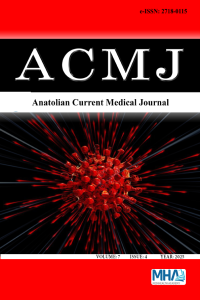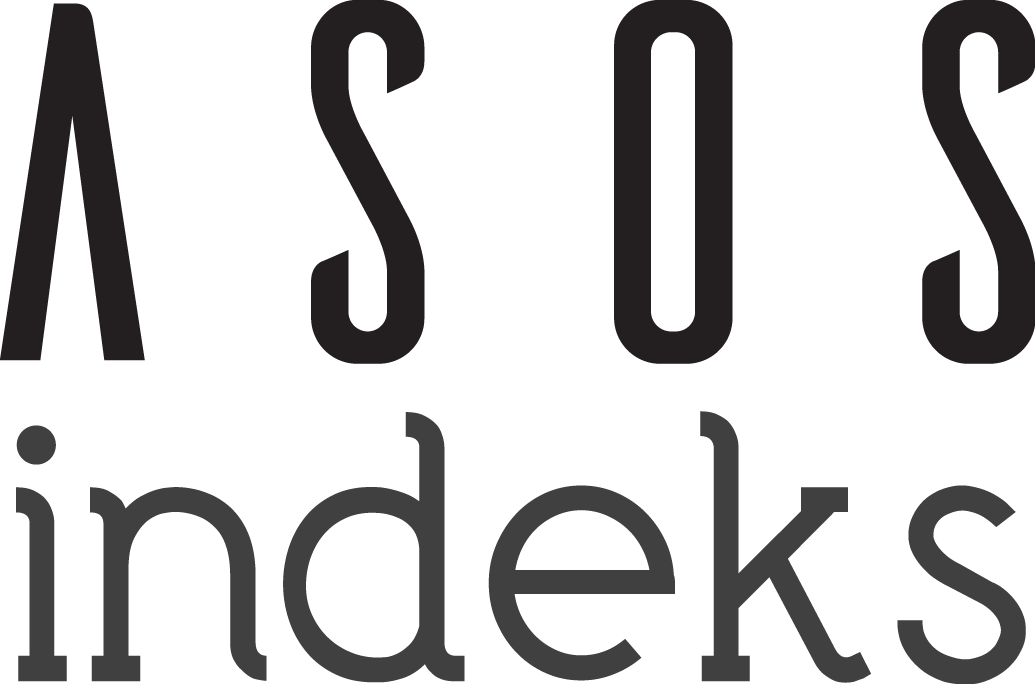Abstract
Aims: Coronary artery ectasia (CAE) is defined as the dilation of a coronary artery to at least 1.5 times the diameter of the adjacent normal segment, detected in 0.3%-5.3% of coronary angiographies. The body-mass index (BMI), calculated as weight (kg) divided by height squared (m²), is the simplest measure for diagnosing obesity. Obesity is linked to cardiovascular diseases, including CAE, type 2 diabetes, hypertension, and certain cancers, with higher BMI increasing the risk of disease. This study aimed to assess the BMI in patients with CAE and to investigate its potential association with the presence of the disease.
Methods: In our clinic, CAE patients diagnosed via coronary angiography were retrospectively evaluated, and their BMI values were compared. BMI was calculated using height and weight records from the hospital’s automation system. The study included 111 patients and 111 control individuals.
Results: A total of 222 patients were enrolled in the study. It was observed that BMI values were significantly higher in individuals diagnosed with CAE compared to the control group. Moreover, several clinical parameters, including advanced age, diabetes mellitus, hypertension, smoking, and elevated low-density lipoprotein cholesterol (LDL) levels, were associated with the presence of CAE.
Conclusion: In this study, BMI was significantly higher in CAE patients. Obesity may contribute to CAE through metabolic factors. Further research is needed to clarify the mechanisms and assess the benefits of weight control in CAE prevention.
References
- Ovalı C, Morrad B. Associations between coronary artery disease, aneurysm and ectasia. Kardiochir Torakochirurgia Pol. 2017;14(3):158-163. doi:10.5114/kitp.2017.70276
- Yılmaz M, Nail Bilen M. (2018). An angiographic curiosity: coronary artery ectasia. A review of possible aetiological factors, clinical and histopathological features and treatment. Cardiovasc Disorders Med. 2018;3(4):1-6.
- Ahmad M, Mungee S. Coronary ectasia. In StatPearls [Internet]. StatPearls Publishing. 2022.
- Roh JW, Park EH, Song JC, et al. ST-segment elevation myocardial infarction as a result of coronary artery ectasia-related intracoronary thrombus in a patient with liver cirrhosis. Korean J Crit Care Med. 2015; 30(4):358-364. doi:10.4266/kjccm.2015.30.4.358
- Pekkoç Uyanık KÇ, Kılıçarslan O, Ser Ö, Öztürk O, Yılmaz Aydoğan H. Koroner arter ektazi ve genetik yatkınlık. Halic Uni J Health Sci. 2020; 3(1):27-32.
- Hansson GK, Hermansson A. The immune system in atherosclerosis. Nature Immunology. 2011;12(3):204-212. doi:10.1038/ni.2001
- Baysal SS, Koç Ş, Özbek K, Bayhatun M. Elevated oxidative stress markers as independent predictors of isolated coronary artery ectasia. Postepy Kardiol Interwencyjnej. 2025;21(1):67-72. doi:10.5114/aic.2025.148148
- World Health Organization. Obesity: preventing and managing the global epidemic. Report of a WHO consultation. Geneva: World Health Organization; 2000. (WHO Technical Report Series, No. 894).
- BMI chart with obesity classifications adopted from the WHO 1998 report. Contributed by the World Health Organization-"Report of a WHO consultation on obesity. Obesity Preventing and Managing a Global Epidemic."Obesity Surgery Indications and Contraindications, Treasure Island (FL): StatPearls Publishing; 2025.
- Khan SS, Ning H, Wilkins JT, et al. Association of body-mass index with lifetime risk of cardiovascular disease and compression of morbidity. JAMA Cardiol. 2018;3(4):280-287. doi:10.1001/jamacardio. 2018.0022
- Neeland IJ, Ross R, Després JP, et al. Visceral and ectopic fat, atherosclerosis, and cardiometabolic disease: a position statement. Lancet Diabetes Endocrinol. 2019;7(9):715-725. doi:10.1016/S2213-8587 (19)30084-1
- Stefan N, Schick F, Häring HU. Causes, characteristics, and consequences of metabolically unhealthy normal weight in humans. Cell Metabolism. 2017;26(2):292-300. doi:10.1016/j.cmet.2017.07.008
- Poirier P, Giles TD, Bray GA, et al. Obesity and cardiovascular disease: pathophysiology, evaluation, and effect of weight loss: an update of the 1997 American Heart Association Scientific Statement on Obesity and Heart Disease from the Obesity Committee of the Council on Nutrition, Physical Activity, and Metabolism. Circulation. 2006;113(6):898-918. doi:10.1161/CIRCULATIONAHA.106.171016
- Kim JA, Montagnani M, Koh KK, Quon MJ. Reciprocal relationships between insulin resistance and endothelial dysfunction: molecular and pathophysiological mechanisms. Circulation. 2006;113(15):1888-1904. doi:10.1161/CIRCULATIONAHA.105.563213
- Lavie CJ, Milani RV, Ventura HO. Obesity and cardiovascular disease: risk factor, paradox, and impact of weight loss. J Am Coll Cardiol. 2009; 53(21):1925-1932. doi:10.1016/j.jacc.2008.12.068
- Donmez E, Ozcan S. The relationship between obesity and coronary artery ectasia in patients presenting with acute coronary syndromes. Ann Med Res. 2023;30(2):161-166.
- Libby P, Ridker PM, Hansson GK; Leducq Transatlantic Network on Atherothrombosis. Inflammation in atherosclerosis: from pathophysiology to practice. J Am Coll Cardiol. 2009;54(23):2129-2138. doi:10.1016/j.jacc.2009.09.009
- Lavie CJ, Laddu D, Arena R, Ortega FB, Alpert MA, Kushner RF. Healthy weight and obesity prevention: JACC health promotion series. J Am Coll Cardiol. 2018;72(13):1506-1531. doi:10.1016/j.jacc.2018.08.1037
- Richards GHC, Hong KL, Henein MY, Hanratty C, Boles U. Coronary artery ectasia: review of the non-atherosclerotic molecular and pathophysiologic concepts. Int J Mol Sci. 2022;23(9):5195. doi:10.3390/ijms23095195
- Jiang L, Wei W, Kang S, Li XL, Luo Y. Insights into lipid metabolism and immune-inflammatory responses in the pathogenesis of coronary artery ectasia. Front Physiol. 2023;14:1096991. doi:10.3389/fphys.2023.1096991
- Kwaifa IK, Bahari H, Yong YK, Noor SM. Endothelial dysfunction in obesity-induced inflammation: molecular mechanisms and clinical implications. Biomolecules. 2020;10(2):291. doi:10.3390/biom10020291
- Iacobellis G. Epicardial adipose tissue in contemporary cardiology. Nat Rev Cardiol. 2022;19(9):593-606. doi:10.1038/s41569-022-00679-9
- Cai Z, Li L, Wang H, et al. Effect of type 2 diabetes on coronary artery ectasia: smaller lesion diameter and shorter lesion length but similar adverse cardiovascular events. Cardiovasc Diabetol. 2022;21(1):9. doi:10. 1186/s12933-022-01444-5
- Mu J, Weng Y, Xiao J, et al. Association of remnant cholesterol with coronary artery ectasia: a cross-sectional study. Lipids Health Dis. 2024; 23(1):240. doi:10.1186/s12944-024-02225-7
- Qin Y, Tang C, Ma C, Yan G. Risk factors for coronary artery ectasia and the relationship between hyperlipidemia and coronary artery ectasia. Coron Artery Dis. 2019;30(3):211-215. doi:10.1097/MCA.0000000000000709
- Humphrey JD. Mechanisms of vascular remodeling in hypertension. Am J Hypertens. 2021;34(5):432-441. doi:10.1093/ajh/hpaa195
- Xi Z, Qiu H, Guo T, et al. Prevalence, predictors, and impact of coronary artery ectasia in patients with atherosclerotic heart disease. Angiology. 2023;74(1):47-54. doi:10.1177/00033197221091644
- Rojas-Milán E, León CEM, García-Rincón A, et al. Cardiovascular risk factors associated with coronary ectasia and acute myocardial infarction. Factores de riesgo cardiovascular asociados a ectasia coronaria e infarto agudo de miocardio. Gac Med Mex. 2021;157(6):604-609. doi:10.24875/GMM.M21000624
- Selthofer-Relatić K, Bošnjak I, Kibel A. Obesity Related coronary microvascular dysfunction: from basic to clinical practice. Cardiol Res Pract. 2016;2016:8173816. doi:10.1155/2016/8173816
Abstract
Aims: Coronary artery ectasia (CAE) is defined as the dilation of a coronary artery to at least 1.5 times the diameter of the adjacent normal segment, detected in 0.3%-5.3% of coronary angiographies. The body-mass index (BMI), calculated as weight (kg) divided by height squared (m²), is the simplest measure for diagnosing obesity. Obesity is linked to cardiovascular diseases, including CAE, type 2 diabetes, hypertension, and certain cancers, with higher BMI increasing the risk of disease. This study aimed to assess the BMI in patients with CAE and to investigate its potential association with the presence of the disease.
Methods: In our clinic, CAE patients diagnosed via coronary angiography were retrospectively evaluated, and their BMI values were compared. BMI was calculated using height and weight records from the hospital’s automation system. The study included 111 patients and 111 control individuals.
Results: A total of 222 patients were enrolled in the study. It was observed that BMI values were significantly higher in individuals diagnosed with CAE compared to the control group. Moreover, several clinical parameters, including advanced age, diabetes mellitus, hypertension, smoking, and elevated low-density lipoprotein cholesterol (LDL) levels, were associated with the presence of CAE.
Conclusion: In this study, BMI was significantly higher in CAE patients. Obesity may contribute to CAE through metabolic factors. Further research is needed to clarify the mechanisms and assess the benefits of weight control in CAE prevention.
References
- Ovalı C, Morrad B. Associations between coronary artery disease, aneurysm and ectasia. Kardiochir Torakochirurgia Pol. 2017;14(3):158-163. doi:10.5114/kitp.2017.70276
- Yılmaz M, Nail Bilen M. (2018). An angiographic curiosity: coronary artery ectasia. A review of possible aetiological factors, clinical and histopathological features and treatment. Cardiovasc Disorders Med. 2018;3(4):1-6.
- Ahmad M, Mungee S. Coronary ectasia. In StatPearls [Internet]. StatPearls Publishing. 2022.
- Roh JW, Park EH, Song JC, et al. ST-segment elevation myocardial infarction as a result of coronary artery ectasia-related intracoronary thrombus in a patient with liver cirrhosis. Korean J Crit Care Med. 2015; 30(4):358-364. doi:10.4266/kjccm.2015.30.4.358
- Pekkoç Uyanık KÇ, Kılıçarslan O, Ser Ö, Öztürk O, Yılmaz Aydoğan H. Koroner arter ektazi ve genetik yatkınlık. Halic Uni J Health Sci. 2020; 3(1):27-32.
- Hansson GK, Hermansson A. The immune system in atherosclerosis. Nature Immunology. 2011;12(3):204-212. doi:10.1038/ni.2001
- Baysal SS, Koç Ş, Özbek K, Bayhatun M. Elevated oxidative stress markers as independent predictors of isolated coronary artery ectasia. Postepy Kardiol Interwencyjnej. 2025;21(1):67-72. doi:10.5114/aic.2025.148148
- World Health Organization. Obesity: preventing and managing the global epidemic. Report of a WHO consultation. Geneva: World Health Organization; 2000. (WHO Technical Report Series, No. 894).
- BMI chart with obesity classifications adopted from the WHO 1998 report. Contributed by the World Health Organization-"Report of a WHO consultation on obesity. Obesity Preventing and Managing a Global Epidemic."Obesity Surgery Indications and Contraindications, Treasure Island (FL): StatPearls Publishing; 2025.
- Khan SS, Ning H, Wilkins JT, et al. Association of body-mass index with lifetime risk of cardiovascular disease and compression of morbidity. JAMA Cardiol. 2018;3(4):280-287. doi:10.1001/jamacardio. 2018.0022
- Neeland IJ, Ross R, Després JP, et al. Visceral and ectopic fat, atherosclerosis, and cardiometabolic disease: a position statement. Lancet Diabetes Endocrinol. 2019;7(9):715-725. doi:10.1016/S2213-8587 (19)30084-1
- Stefan N, Schick F, Häring HU. Causes, characteristics, and consequences of metabolically unhealthy normal weight in humans. Cell Metabolism. 2017;26(2):292-300. doi:10.1016/j.cmet.2017.07.008
- Poirier P, Giles TD, Bray GA, et al. Obesity and cardiovascular disease: pathophysiology, evaluation, and effect of weight loss: an update of the 1997 American Heart Association Scientific Statement on Obesity and Heart Disease from the Obesity Committee of the Council on Nutrition, Physical Activity, and Metabolism. Circulation. 2006;113(6):898-918. doi:10.1161/CIRCULATIONAHA.106.171016
- Kim JA, Montagnani M, Koh KK, Quon MJ. Reciprocal relationships between insulin resistance and endothelial dysfunction: molecular and pathophysiological mechanisms. Circulation. 2006;113(15):1888-1904. doi:10.1161/CIRCULATIONAHA.105.563213
- Lavie CJ, Milani RV, Ventura HO. Obesity and cardiovascular disease: risk factor, paradox, and impact of weight loss. J Am Coll Cardiol. 2009; 53(21):1925-1932. doi:10.1016/j.jacc.2008.12.068
- Donmez E, Ozcan S. The relationship between obesity and coronary artery ectasia in patients presenting with acute coronary syndromes. Ann Med Res. 2023;30(2):161-166.
- Libby P, Ridker PM, Hansson GK; Leducq Transatlantic Network on Atherothrombosis. Inflammation in atherosclerosis: from pathophysiology to practice. J Am Coll Cardiol. 2009;54(23):2129-2138. doi:10.1016/j.jacc.2009.09.009
- Lavie CJ, Laddu D, Arena R, Ortega FB, Alpert MA, Kushner RF. Healthy weight and obesity prevention: JACC health promotion series. J Am Coll Cardiol. 2018;72(13):1506-1531. doi:10.1016/j.jacc.2018.08.1037
- Richards GHC, Hong KL, Henein MY, Hanratty C, Boles U. Coronary artery ectasia: review of the non-atherosclerotic molecular and pathophysiologic concepts. Int J Mol Sci. 2022;23(9):5195. doi:10.3390/ijms23095195
- Jiang L, Wei W, Kang S, Li XL, Luo Y. Insights into lipid metabolism and immune-inflammatory responses in the pathogenesis of coronary artery ectasia. Front Physiol. 2023;14:1096991. doi:10.3389/fphys.2023.1096991
- Kwaifa IK, Bahari H, Yong YK, Noor SM. Endothelial dysfunction in obesity-induced inflammation: molecular mechanisms and clinical implications. Biomolecules. 2020;10(2):291. doi:10.3390/biom10020291
- Iacobellis G. Epicardial adipose tissue in contemporary cardiology. Nat Rev Cardiol. 2022;19(9):593-606. doi:10.1038/s41569-022-00679-9
- Cai Z, Li L, Wang H, et al. Effect of type 2 diabetes on coronary artery ectasia: smaller lesion diameter and shorter lesion length but similar adverse cardiovascular events. Cardiovasc Diabetol. 2022;21(1):9. doi:10. 1186/s12933-022-01444-5
- Mu J, Weng Y, Xiao J, et al. Association of remnant cholesterol with coronary artery ectasia: a cross-sectional study. Lipids Health Dis. 2024; 23(1):240. doi:10.1186/s12944-024-02225-7
- Qin Y, Tang C, Ma C, Yan G. Risk factors for coronary artery ectasia and the relationship between hyperlipidemia and coronary artery ectasia. Coron Artery Dis. 2019;30(3):211-215. doi:10.1097/MCA.0000000000000709
- Humphrey JD. Mechanisms of vascular remodeling in hypertension. Am J Hypertens. 2021;34(5):432-441. doi:10.1093/ajh/hpaa195
- Xi Z, Qiu H, Guo T, et al. Prevalence, predictors, and impact of coronary artery ectasia in patients with atherosclerotic heart disease. Angiology. 2023;74(1):47-54. doi:10.1177/00033197221091644
- Rojas-Milán E, León CEM, García-Rincón A, et al. Cardiovascular risk factors associated with coronary ectasia and acute myocardial infarction. Factores de riesgo cardiovascular asociados a ectasia coronaria e infarto agudo de miocardio. Gac Med Mex. 2021;157(6):604-609. doi:10.24875/GMM.M21000624
- Selthofer-Relatić K, Bošnjak I, Kibel A. Obesity Related coronary microvascular dysfunction: from basic to clinical practice. Cardiol Res Pract. 2016;2016:8173816. doi:10.1155/2016/8173816
Details
| Primary Language | English |
|---|---|
| Subjects | Cardiology |
| Journal Section | Research Articles |
| Authors | |
| Publication Date | July 28, 2025 |
| Submission Date | May 5, 2025 |
| Acceptance Date | June 13, 2025 |
| Published in Issue | Year 2025 Volume: 7 Issue: 4 |
TR DİZİN ULAKBİM and International Indexes (1b)
Interuniversity Board (UAK) Equivalency: Article published in Ulakbim TR Index journal [10 POINTS], and Article published in other (excuding 1a, b, c) international indexed journal (1d) [5 POINTS]
Note: Our journal is not WOS indexed and therefore is not classified as Q.
You can download Council of Higher Education (CoHG) [Yüksek Öğretim Kurumu (YÖK)] Criteria) decisions about predatory/questionable journals and the author's clarification text and journal charge policy from your browser. https://dergipark.org.tr/tr/journal/3449/file/4924/show
Journal Indexes and Platforms:
TR Dizin ULAKBİM, Google Scholar, Crossref, Worldcat (OCLC), DRJI, EuroPub, OpenAIRE, Turkiye Citation Index, Turk Medline, ROAD, ICI World of Journal's, Index Copernicus, ASOS Index, General Impact Factor, Scilit.The indexes of the journal's are;
The platforms of the journal's are;
|
The indexes/platforms of the journal are;
TR Dizin Ulakbim, Crossref (DOI), Google Scholar, EuroPub, Directory of Research Journal İndexing (DRJI), Worldcat (OCLC), OpenAIRE, ASOS Index, ROAD, Turkiye Citation Index, ICI World of Journal's, Index Copernicus, Turk Medline, General Impact Factor, Scilit
Journal articles are evaluated as "Double-Blind Peer Review"
All articles published in this journal are licensed under a Creative Commons Attribution 4.0 International License (CC BY 4.0)














